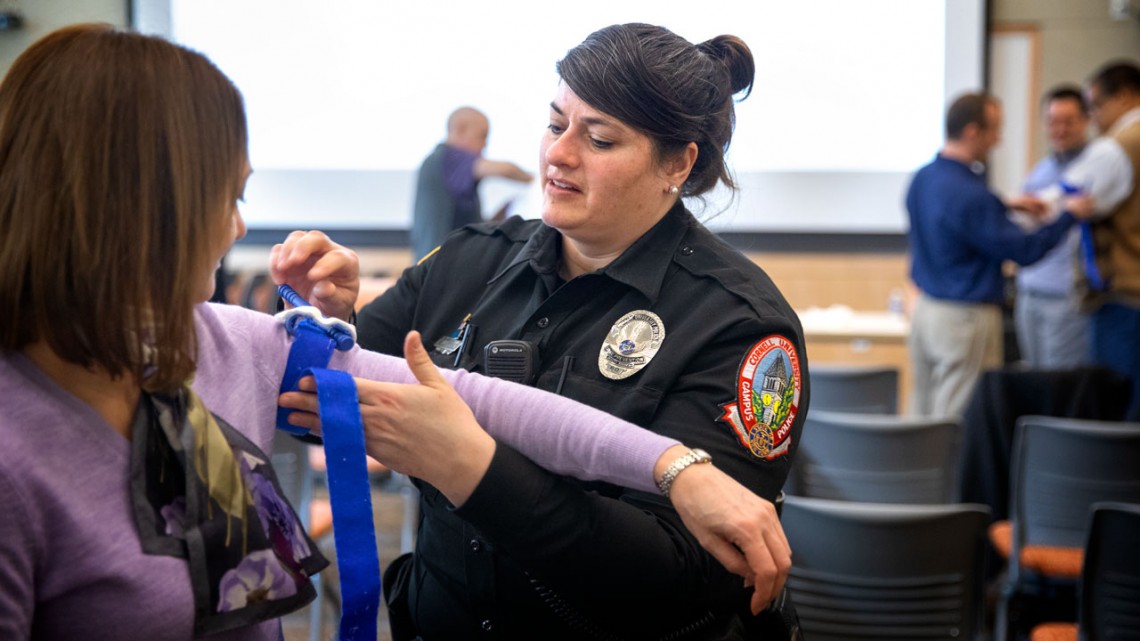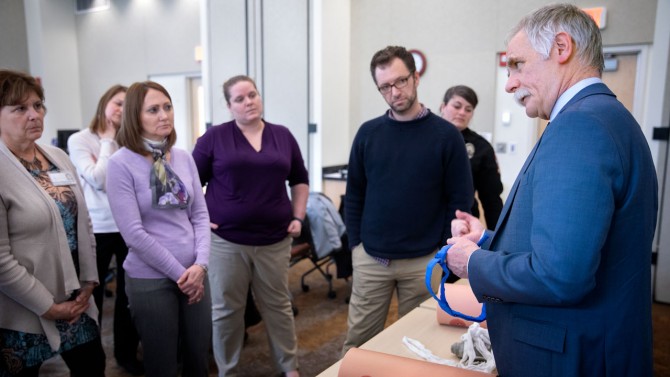
Cornell Police Officer Beverly Van Cleef practices applying a combat application tourniquet on Karen Kelley, director of research safety in Environmental Health & Safety, during a train-the-trainers session for the Stop the Bleed program, an effort to teach basic bleeding control.
Bleeding-control basics taught at Cornell Health sessions
By Gary E. Frank
The technical term is “exsanguination.” In lay terms, it’s a severe loss of blood – and it is the top cause of preventable death in trauma cases. Experts estimate that 20 percent of people who have died from traumatic injuries could have survived with fast action to control bleeding.
Two trauma surgeons from Weill Cornell Medicine held a pair of “Stop the Bleed” train-the-trainer sessions on Feb. 11 at Cornell Health. The sessions were attended by more than 30 staff members from Cornell Health, Cornell Police, Cornell Facilities and Campus Services, and Environmental Health and Safety, as well as the student-led University Emergency Medical Service. The sessions’ goals were to increase awareness of the program and create a cadre of trainers for the campus community.
“Many times, in the case of a severe hemorrhage, the people who can save someone’s life are not working in a hospital like me,” said Dr. Robert Winchell, chief of the Division of Trauma, Burns, Critical and Acute Care and professor of surgery at Weill Cornell Medicine and director of the trauma center at NewYork-Presbyterian/Weill Cornell Medical Center.
“If you can get to the hospital, you kind of have it made,” he said. “But in fact, stopping the bleeding really has to happen at the scene, by trained first responders if you’re lucky, but more likely it will be by bystanders who are there in time to make a difference.”
The purpose of the Stop the Bleed campaign is to better prepare the public to save lives by raising awareness of basic actions to stop life-threatening bleeding following everyday emergencies, natural disasters or other crises situations.
Training consisted of a classroom component highlighting the basics of bleeding control, followed by a hands-on component practicing the techniques and equipment. The training sessions emphasized the importance of more citizens learning proper bleeding control techniques, including how to use their hands, dressings and tourniquets. Trauma victims can die from uncontrolled bleeding within five to 10 minutes.
“It is important to remember that you can’t help someone if you’re in danger yourself,” said Dr. Mayur Narayan, assistant professor of surgery (interim) at Weill Cornell Medicine and a trauma surgeon at NewYork-Presbyterian/Weill Cornell Medical Center, who co-led the training sessions. He encouraged bystanders to first call 911 or ask someone else to call, and to ensure their personal safety before attending to victims.
Bleeding control kits will be installed in Automated External Defibrillator cabinets around campus and in Cornell Police and Environmental Health and Safety emergency response vehicles, said Frank Cantone, director of Cornell’s Office of Emergency Management.
“Serious injuries can occur at any time,” said Cantone. “We feel that this an important skill that bystanders can easily learn and apply in the event of an emergency.”
Gary E. Frank is a staff writer in Strategic Communications.
Media Contact
Get Cornell news delivered right to your inbox.
Subscribe

